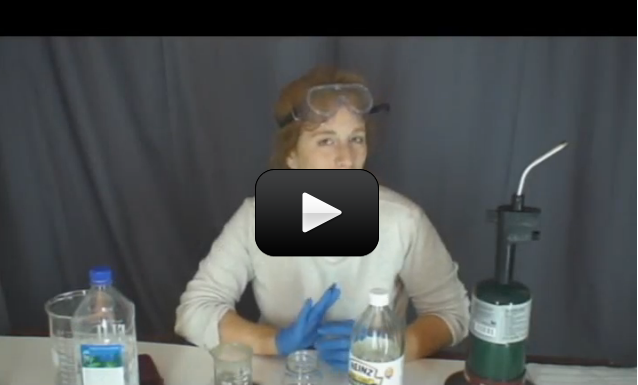No kidding! You’ll be able to show your friends this super-cool magic show chemistry trick with very little fuss (once you get the hang of it). This experiment is for advanced students. Before we start, here are a few notes about the setup to keep you safe and your nasal passages intact:
The chemicals required for this experiment are toxic! This is not an experiment to do with little kids or pets around, and you want to do the entire experiment outside or next to an open window for good ventilation, as the fumes from the sodium hydroxide/zinc solution should not be inhaled.
This experiment is not dangerous when you follow the steps I’ve outlined carefully. I’ll take you step by step and show you how to handle the chemicals, mix them properly, and dispose of the waste when you’re done.
Goggles and gloves are a MUST for this experiment, as the sodium hydroxide (in both liquid and solid form) is caustic and corrosive and will burn your skin on contact.
[am4show have=’p8;p9;p11;p38;p92;p45;p91;’ guest_error=’Guest error message’ user_error=’User error message’ ]
Is it REAL gold?
No. But it’s very close in color, as is the ‘silver’. The basic idea behind the experiment is this: by cleaning the pennies in the first step, you clear off any oxide layers to expose the copper surface. When you dip it in the solution, a galvanization reaction starts (just like ‘galvanized nails’) covering the penny with a metallic silver zinc coating.
The torching process fuses the zinc and the copper together to make the gold colored brass coating. Be careful, though, as brass has a low melting temperature and if you leave it in the flame too long, you’ll burn off the brass coating.
Materials:
- propane torch with adult help
- shiny copper pennies
- distilled white vinegar
- Pyrex glass beaker
- sodium hydroxide (solid)
- zinc powder (dust)
- alcohol burner
- stand that fits over the alcohol burner
- lighter with adult help
- wire mesh screen
- popsicle sticks
- water
- salt
- disposable cup
- gloves
- goggles
- tweezers or pliers
Download Student Worksheet & Exercises
The chemical reaction plates the copper on the penny with zinc (called galvanization). The zinc reacts with the hot sodium hydroxide solution to form soluble sodium zincate (Na2ZnO2), which is converted to metallic zinc when it hits the surface of the penny.
Heating the penny fuses the zinc and copper together to form an alloy called brass. The amounts of copper and zinc in brass can vary a lot, from 60-82% copper and 18-40% zinc.
DISPOSAL INSTRUCTIONS: If you simply wipe out the beaker with a paper towel and toss it in the trash, you run the risk of igniting your trash can because the combination of sodium hydroxide and zinc is very exothermic (lots of heat is generated).
Make sure to use plenty of water to remove the sodium hydroxide first before removing the metal. Sodium hydroxide will not harm the plumbing in the sink as it is also used as a drain cleaner (dissolves hair, etc.) but don’t get it on your hands! Vinegar will neutralize any residual sodium hydroxide.
[/am4show]


this is so amazing
It is best to use goggles. Safety glasses don’t provide as much protection from splashes.
Can I use safety glasses?